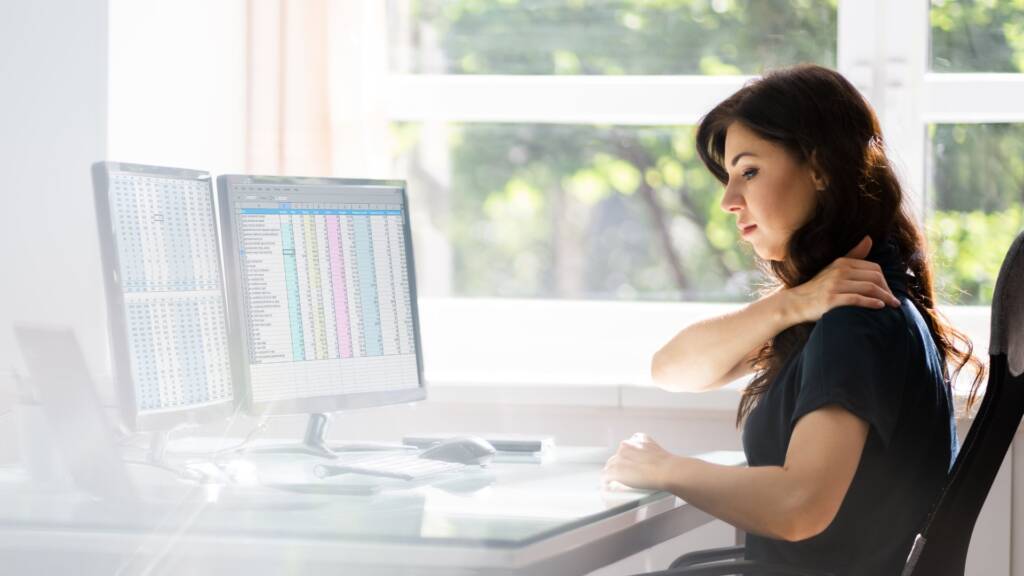Introduction
The use of devices is an integral part of our lives in present times. On an average we are using devices for 3-4 hours in a day be it a desktop, laptop, or mobile. The stresses put on the musculature and the joints is not what our system was designed for. So this workplace and recreational use of devices is leading to a new range of orthopedic symptoms for which good workplace ergonomics and prevention of stress is important so as to work at our best productivity.
As ortho specialist in Dubai, we understand that maintaining orthopedic health goes beyond the playing field. In this blog, we’ll discuss the importance of workplace ergonomics and offer tips to prevent orthopedic problems such as muscle strain, muscle tear, ligaments injuries, etc while working in an office environment. The Impact of Poor Ergonomics
Sitting at a desk for prolonged periods with improper posture and workstation setup can lead to a variety of orthopedic issues, including:
Back Pain: Slouching or sitting with poor posture can cause muscle strain and can also strain ligaments in the back, leading to discomfort and pain.
Neck and Shoulder Pain: Incorrect monitor placement or repetitive movements can cause neck and shoulder strain, resulting in stiffness and pain.
Carpal Tunnel Syndrome: Poorly positioned keyboards or mouse devices can contribute to compression of the median nerve in the wrist, leading to carpal tunnel syndrome and hand pain.
Eye Strain: Improper monitor height or inadequate lighting can cause eye strain and fatigue, leading to headaches and vision problems.
Leg and feet swelling due to constant sitting position.

Preventing Orthopedic Issues in the Office
Optimize Your Workstation: Arrange your desk, chair, and computer equipment to promote good posture and comfort. Ensure that your monitor is at eye level, your keyboard and mouse are at a comfortable distance, and your chair supports your lower back. There are 3 zones of your desk.
1: which can be accessed without extending your elbow.called as PRIMARY ZONE where you need to keep all the essential items like you mouse, keypad, hard disk
2: SECONDARY ZONE : which can be accessed with your elbow extended .; where less frequent items like you telephone , printer , stationery can be kept.
3: TERTIARY ZONE ; which needs to accessed by getting up from your chair ;where the other items which are use only once or twice a day can be kept
Take Regular Breaks: Avoid sitting for long periods without breaks. Set reminders to stand up, stretch, and walk around for 5 minutes every hour to reduce stiffness, muscle strain and improve circulation.
Practice Proper Posture: Sit with your back straight, shoulders relaxed, and feet flat on the floor. Keep your elbows close to your body and your wrists in a neutral position while typing.
Use Ergonomic Equipment: Invest in ergonomic office furniture and accessories, such as an adjustable chair, ergonomic keyboard and mouse, and a footrest, to support proper posture and reduce strain.
Adjust Your Monitor: Position your monitor directly in front of you at arm’s length, with the top of the screen at or slightly below eye level. Use a document holder to keep reference materials at eye level and reduce neck strain.
Lighting and Glare Reduction: Ensure adequate lighting in your workspace to reduce eye strain. Position your monitor to minimize glare from windows or overhead lights, and consider using an anti-glare screen if necessary.
Stay Active: Incorporate movement into your workday by taking short walks during breaks, using a standing desk, or doing stretching exercises at your desk to relieve muscle tension.
Stay Hydrated: Drink plenty of water throughout the day to keep your muscles and joints hydrated and flexible.
Conclusion
Prioritizing workplace ergonomics is essential for preventing orthopedic issues and maintaining overall musculoskeletal health. By optimizing your workstation setup, practicing good posture, taking regular breaks, and staying active, you can reduce the risk of developing orthopedic problems associated with office work. As ortho specialist in Dubai, we encourage individuals to prioritize their orthopedic health both on and off the field. If you experience persistent pain or discomfort despite ergonomic adjustments, consult with a healthcare professional for further evaluation and treatment.

